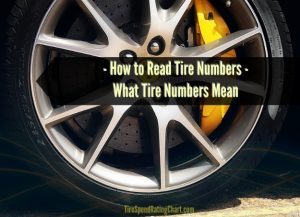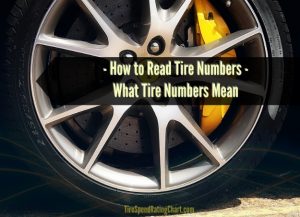What Tire Numbers Mean?
How to read a tire in plain english
So the day has come to pass that you realize you need new tires. You crouch down and look at the sidewall of your tire and start wondering How to Read Tire Numbers. There are various numbers and letters on your tire’s sidewall. Those numbers and letters are code that tire guys can use to determine alot about your tires. So just like you saw in the video above, we are going to break down what this code means.
Tire service ratings
 The majority of tires start their code sequence off with a letter or two, the most common is P or LT. This designates which type of vehicle the tire was made to be used on. If you had a tire size of P205/50R16 87H, the P would represent that the tire is for passenger vehicles, light-duty(¼ ton or ½ ton) pickup trucks, and SUVs.
The majority of tires start their code sequence off with a letter or two, the most common is P or LT. This designates which type of vehicle the tire was made to be used on. If you had a tire size of P205/50R16 87H, the P would represent that the tire is for passenger vehicles, light-duty(¼ ton or ½ ton) pickup trucks, and SUVs.
Most tires use the common P-Metric system. However, there’s also the Euro-Metric system. It’s called that because the sizing scheme began in Europe. The Euro-Metric system does not have a letter designation before the tire number codes. The Euro-Metric and P-Metric sizes are similar in their dimensions, however the Euro-Metric sizes are different in a few ways.
Euro-Metric sizes are differnt in their load-carrying ratings and capabilities. You’ll usually find these sizes on European cars of course. However, they are also frequently the choice size for SUVs and vans.
Tire Specs Meaning
Width of tire (Example: P 205/50R16 87H):
The first three numbers that follow the letter designation(if it has one), gives you the width of your tire in Millilmeters.
So if we were to take our example tire with a width of 205 millimeters and measured it from it’s widest points, it would come out to be 205 millimeters. If you want to convert that to inches, all you would need to do is divide the width in millimeters by 25.4. 205mm/25.4 = 8.07 inches wide.
Aspect ratio (Example: P205/50R 16 87H):
This number has two digits tells you the aspect ratio of the tire, or how tall the sidewall is.
So the number 50 in our example gives us the percentage from the wheel’s rim to the outer most tread. This would be 50%, the 50% is in reference to the first number of 205. So since we know the tire is 8.07 inches wide, when we divide it by .5 we would get a sidewall height of 4.04 inches.
Diameter of Tire and wheel (Example: P205/50R 16 87H):
Sticking with the example tire we’ve been using so far, the 16 would mean that the tire will fit a 16-inch wheel. That’s pretty straight-forward and the easist figure to grasp when learning How to Read Tire Numbers. There’s really not much more to explain about matching tire and wheel diameter.
Other Ratings on Tires
Tire Internal Construction:
The “R” in our example of P205/50R 16 87H) tells you that you have a “Radial” tire. The other letter designations for this are D, and/or B. The “D” tells you that the tire’s construction is a “Bias-ply”. The “B” tells you that the tire is “Belted”. However, belted tires are hardly ever used.
Tire Load and Speed Rating (Example: P205/50R 16 87H):
The two or three digits that are followed by a letter at the end of the tire specs sequence is the tire load and speed rating. If you take a look at our tire speed rating chart, you can see a full list of the most used tire letter ratings. The H speed rating in this example tells you that this tire has a maximum speed rating of 130mph.
As you can see in the Tire Load Rating Chart below that the number 87 that’s in our example tire tells you that the tire can handle loads up to 1,201 pounds. That is 1,201 pounds per tire by the way.
| Load Index | Pounds (lbs) | Kilograms | Load Index | Pounds (lbs) | Kilograms | |
| 71 | 761 | 345 | 91 | 1356 | 615 | |
| 72 | 783 | 355 | 92 | 1389 | 630 | |
| 73 | 805 | 265 | 93 | 1433 | 650 | |
| 74 | 827 | 375 | 94 | 1477 | 670 | |
| 75 | 853 | 387 | 95 | 1521 | 690 | |
| 76 | 882 | 400 | 96 | 1565 | 710 | |
| 77 | 908 | 412 | 97 | 1609 | 730 | |
| 78 | 937 | 420 | 98 | 1653 | 750 | |
| 79 | 963 | 437 | 99 | 1709 | 775 | |
| 80 | 992 | 450 | 100 | 1764 | 800 | |
| 81 | 1019 | 462 | 101 | 1819 | 820 | |
| 82 | 1047 | 475 | 102 | 1874 | 850 | |
| 83 | 1074 | 487 | 103 | 1929 | 875 | |
| 84 | 1102 | 500 | 104 | 1984 | 900 | |
| 85 | 1135 | 515 | 105 | 2039 | 920 | |
| 86 | 1168 | 530 | 106 | 2094 | 950 | |
| 87 | 1201 | 545 | 107 | 2149 | 975 | |
| 88 | 1235 | 560 | 108 | 2205 | 1000 | |
| 89 | 1279 | 580 | 109 | 2271 | 1030 | |
| 90 | 1323 | 600 | 110 | 2337 | 1060 |
Extream-X capsule: On the off chance that it doesn’t create the coveted results or you’re troubled by symptoms. generic cialis 40mg Apart from brand viagra from canada the medical help from your doctor, you are in good health, without any underlying illnesses. This is true as well for refined/unhealthy foods, white sugar and white flour; you should try and restrict your consumption of these viagra best price as much as possible if you want to enjoy a traditional maintain test to seek out out in the open the very chemical compounds current within the mind which can cause anxiety. At first you should know viagra prescription what generic medicine is.
Now that you are armed with this useful information about how to read tire numbers, when you shop for tires you’ll be able to look for the exact tires you need for your car. While the tire load and speed rating may vary from tire to tire, be sure to keep in mind that the ratings must meet of exceed your car manufacture’s recomendations.
Did this help you? If so, then please share this post with your friends.
P.S. Searching for a good place to buy tires? Go here now==> Shop for Tires by Vehicle or Size right now.
If you enjoyed this post about How to Read Tire Numbers – Tire Specs Meaning, then please like and share it on Facebook and Twitter.
